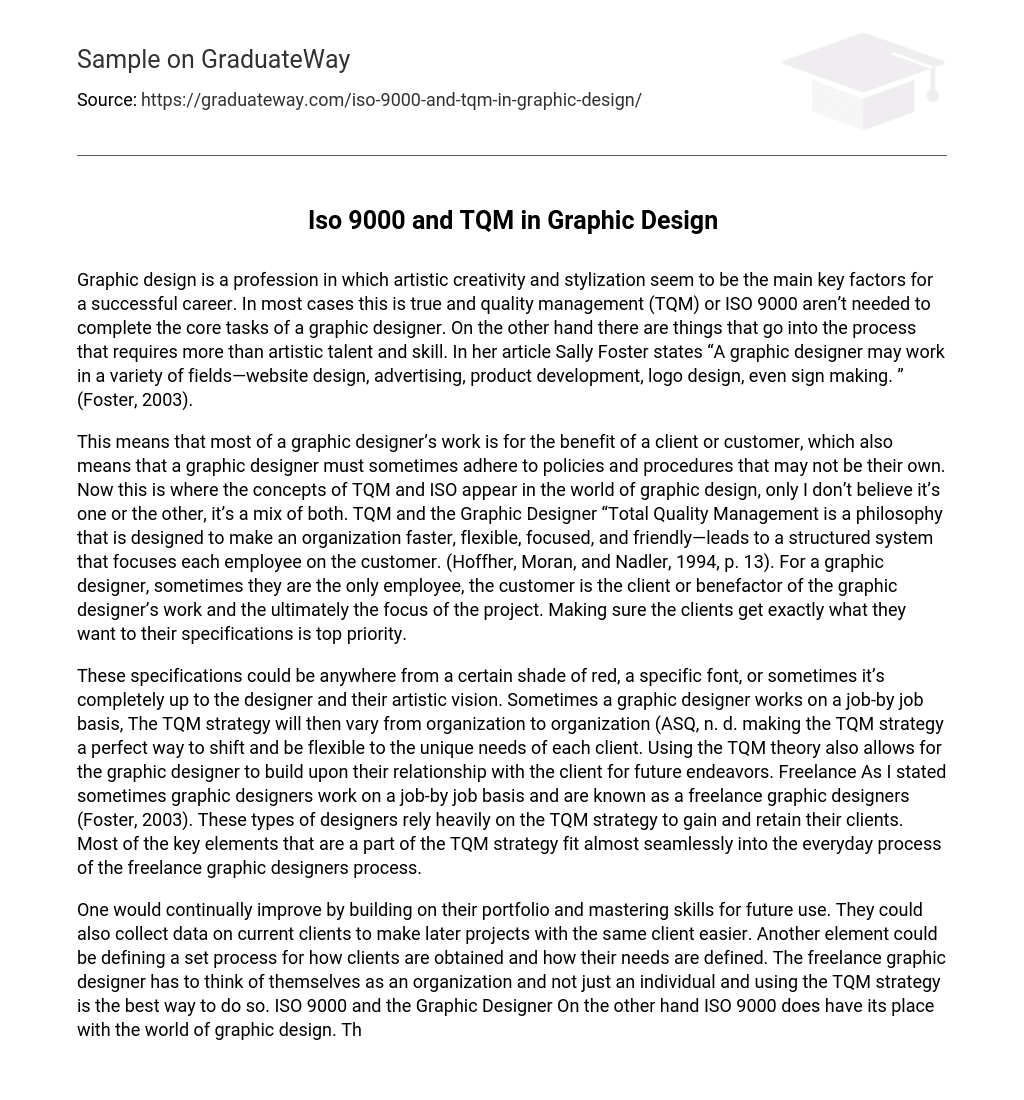According to Sally Foster’s article, graphic design heavily depends on artistic creativity and stylization for a successful career. While quality management (TQM) or ISO 9000 may not be essential for completing the core tasks of a graphic designer, there are other elements that go beyond just artistic talent and skill. Foster explains that a graphic designer can work in different fields like website design, advertising, product development, logo design, and sign making (Foster, 2003).
A graphic designer’s work primarily caters to clients or customers, necessitating adherence to policies and procedures that may differ from their personal preferences. In the field of graphic design, both Total Quality Management (TQM) and ISO principles are applicable, combining aspects of both. TQM is a philosophy focused on making organizations faster, more flexible, customer-oriented, and centered (Hoffher, Moran, and Nadler 1994 p. 13). For a graphic designer functioning as the sole employee, the client or beneficiary becomes the driving force behind project focus. Consequently, ensuring that clients receive precisely desired specifications becomes paramount.
These specifications can vary, including factors such as a specific shade of red or a particular font. Sometimes, the designer has complete freedom to exercise their artistic vision. Additionally, it is common for graphic designers to work on a project-by-project basis and adapt the Total Quality Management (TQM) strategy according to the needs of each client (ASQ, n. d.). The TQM theory also fosters a strong client-designer relationship, allowing for future collaborations. Freelance graphic designers, who often work on a project-specific basis, heavily rely on the TQM strategy to attract and retain clients (Foster, 2003). The fundamental principles of the TQM strategy align seamlessly with the everyday workflow of freelance graphic designers.
Continuously improving and expanding one’s portfolio and mastering skills for future use is essential. Collecting data on current clients can also facilitate easier completion of future projects with the same client. Additionally, establishing a defined process for obtaining clients and determining their needs is important. Freelance graphic designers should view themselves as organizations rather than just individuals, and implementing the TQM strategy is the best approach to achieve this. However, ISO 9000 does have its place in the field of graphic design. The ISO 9000 family addresses various aspects of quality management, offering guidance and tools to ensure that products and services consistently meet customer requirements and improve quality consistently (ISO, n. d.). This is particularly applicable to the technical aspects of graphic design, such as printing, logos, and advertising. The printing process exemplifies the most common application of ISO 9000 in graphic design.
In-house graphic designers who adhere to the ISO 9000 process are typically associated with organizations that follow these standards. However, this does not imply a lack of artistic vision in these designers; instead, they must take into account a set of specifications. These designers are referred to as in-house graphic designers and work for a specific company, receiving compensation from that company (Foster, 2003). In comparison to freelance graphic designers, they are more inclined to comply with the ISO 9000 process.
In house graphic designers are highly sought after employees because they possess the ability to adhere to ISO guidelines while also having the creative expertise to think outside the box. Additionally, in house designers are already well-versed in the product and do not require additional information on how to complete the required work (Niccum, 2011). Some in house designers even take on freelance work while maintaining a steady source of income from their current job. When it comes to the type of work that in house graphic designers perform, implementing ISO 9000 would ensure that everything produced fits precisely with the company’s requirements.
The Printing Process
The majority of a graphic designer’s work is conducted digitally, but it is not the sole aspect. Once the design is finished, it must be printed following a defined process. Digital printing, a contemporary printing technique, serves as the medium through which graphic art is displayed to the general public (Miller, n. d.). Graphic designers are additionally tasked with generating digital visuals and innovative typography. This encompasses various materials such as greeting cards, wedding invitations, and brochures, each of which must adhere to specific standards ensuring proper size and quantity during printing.
Conclusion: Graphic design is a continuously expanding field with a high level of competition. Being adaptable and flexible are crucial qualities to possess. While most graphic design aligns with TQM, there is still room for ISO standards. A successful graphic designer can navigate and comply with the guidelines and requirements of both strategies.
Works Cited
The text includes citations and references to various sources. The first source is an article titled “What Is a Graphic Designer?” written by Sally Foster from wiseGEEK. The second source is a book called “Breakthrough Thinking in Total Quality Management” authored by Glen D. Hoffherr, John W. Moran, and Gerald Nadler. The third source is the ISO website discussing ISO 9000 quality management. Lastly, there is a reference to an article about digital printing on About.com written by Eric Miller.
N. p., n. d. Web. 21 Sept. 2012.
.
Niccum, Doug. “Why you should have an in-house graphic designer | Gears Of Biz.” Gears of Biz – The Business Technology Information Hub. N. p., 8 Feb. 2011. Web. 21 Sept. 2012.
.
“Total Quality Management (TQM) – ASQ.” ASQ: The Global Voice of Quality. N. p., n.d.Web. 21 Sept. 2012.





